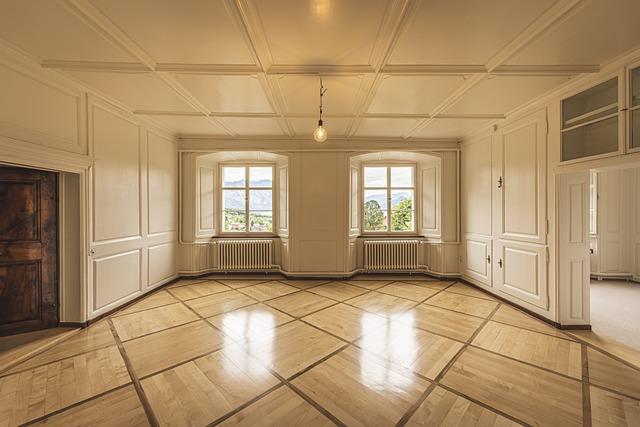When it comes to protecting vacant properties, securing the right insurance coverage is only part of the equation. One often overlooked yet crucial component is the property inspection. Vacant homes present unique risks—ranging from vandalism and theft to unnoticed maintenance issues—that can escalate insurance claims if left unchecked. In this article, we’ll explore why regular property inspections are a vital safeguard for vacant home insurance, helping homeowners and insurers alike minimize risks, ensure policy compliance, and ultimately preserve the value of these unoccupied spaces.
Table of Contents
- The Critical Role of Property Inspections in Risk Assessment for Vacant Homes
- Uncovering Hidden Vulnerabilities Through Thorough Inspection Practices
- How Regular Inspections Inform Accurate Insurance Premiums and Coverage
- Best Practices for Conducting Effective Property Inspections on Vacant Homes
- Key Takeaways
The Critical Role of Property Inspections in Risk Assessment for Vacant Homes
When it comes to insuring vacant properties, diligent inspections are not just a formality—they are a fundamental step in identifying vulnerabilities that increase the risk profile. Regular property inspections help uncover hidden hazards such as structural damage, water leaks, or signs of vandalism, often invisible to the untrained eye. These conditions, if left undiscovered, can escalate repair costs and complicate claim processes, ultimately impacting insurance premiums. Moreover, comprehensive inspections provide detailed documentation of the property’s condition at specific intervals, serving as critical evidence should any disputes arise between owners and insurers.
Insurance providers rely heavily on the insights gathered from these evaluations to tailor policies that effectively mitigate potential losses. Inspections highlight crucial risk factors including:
- Security vulnerabilities like broken locks or inadequate surveillance systems
- Environmental threats such as nearby flooding zones or pest infestations
- Maintenance neglect which might accelerate deterioration or attract trespassers
By proactively addressing these issues, homeowners can work with insurers to implement targeted risk management strategies, ensuring both better protection and more favorable insurance terms.
Uncovering Hidden Vulnerabilities Through Thorough Inspection Practices
Vacant homes are particularly vulnerable to unnoticed damage, making regular, thorough inspections indispensable. A detailed property inspection goes beyond surface-level checks to uncover hidden issues like subtle water leaks, structural weaknesses, or early signs of pest infestations. These hidden vulnerabilities, if left unattended, can escalate into costly repairs or even jeopardize the policyholder’s insurance coverage. For insurers, evidence from meticulous inspections forms the backbone of risk assessment, ensuring that premiums remain fair and reflective of the property’s actual condition.
Key areas that benefit from in-depth scrutiny include:
- Roof and gutters: Small cracks or blockages can lead to water damage.
- Foundation and basement: Early detection of cracks or moisture can prevent extensive mold or structural issues.
- Plumbing and electrical systems: Stagnant water or faulty wiring can become serious fire or flood hazards.
By implementing comprehensive inspection routines, both homeowners and insurers minimize risks while maintaining the home’s integrity long-term—proving that vigilance today wards off costly headaches tomorrow.
How Regular Inspections Inform Accurate Insurance Premiums and Coverage
Insurance providers rely heavily on up-to-date information to tailor premiums and coverage options effectively. By conducting regular inspections, insurers gain a comprehensive view of the property’s current condition, potential risks, and maintenance status. This detailed insight prevents guesswork, ensuring premiums are set fairly based on real risk rather than assumptions. In fact, documented inspections often reveal minor issues before they escalate into costly damage, allowing property owners to address problems proactively and avoid unnecessary premium hikes or coverage limitations down the line.
Key benefits of regular inspections include:
- Risk mitigation: Early identification of hazards such as water damage, structural weaknesses, or pest infestation.
- Accurate risk assessment: Enables insurers to adjust premiums to match the current risk profile precisely.
- Enhanced coverage customization: Allows for tailored policies that meet the property’s unique needs without overpaying for unnecessary protection.
- Improved claims outcomes: Detailed inspection reports expedite claims processing by providing documented proof of the property’s condition prior to any loss.
Best Practices for Conducting Effective Property Inspections on Vacant Homes
To ensure a thorough and accurate assessment, it’s critical to approach inspections with a systematic mindset. Start by creating a detailed checklist tailored specifically for vacant properties, which includes items such as structural integrity, signs of moisture or leaks, electrical systems, and security features. Using digital tools like mobile apps for real-time documentation can significantly reduce human error and provide an organized record for future reference. Additionally, scheduling inspections seasonally helps catch weather-related damages early, preventing costly repairs and potential insurance claims.
Effective communication with insurers and property managers is equally important. Make certain that all findings are clearly documented with high-resolution photos and comprehensive notes. Highlight any early signs of deterioration or vandalism, no matter how minor they may seem. Establishing an ongoing relationship with reputable contractors for immediate repairs can also minimize the risk of extended damage. Regular, proactive inspections not only protect the physical asset but also ensure compliance with insurance policy requirements, ultimately safeguarding the property owner’s investment.
Key Takeaways
In conclusion, property inspections play a crucial role in securing vacant home insurance and safeguarding your investment. By identifying potential risks early and ensuring that the property remains well-maintained, inspections help insurers assess the true condition of the home and provide appropriate coverage. For homeowners, this proactive approach minimizes surprises, reduces the likelihood of costly claims, and ultimately protects the long-term value of their property. If you own a vacant home, prioritizing regular inspections is not just smart—it’s essential for peace of mind and financial security.






